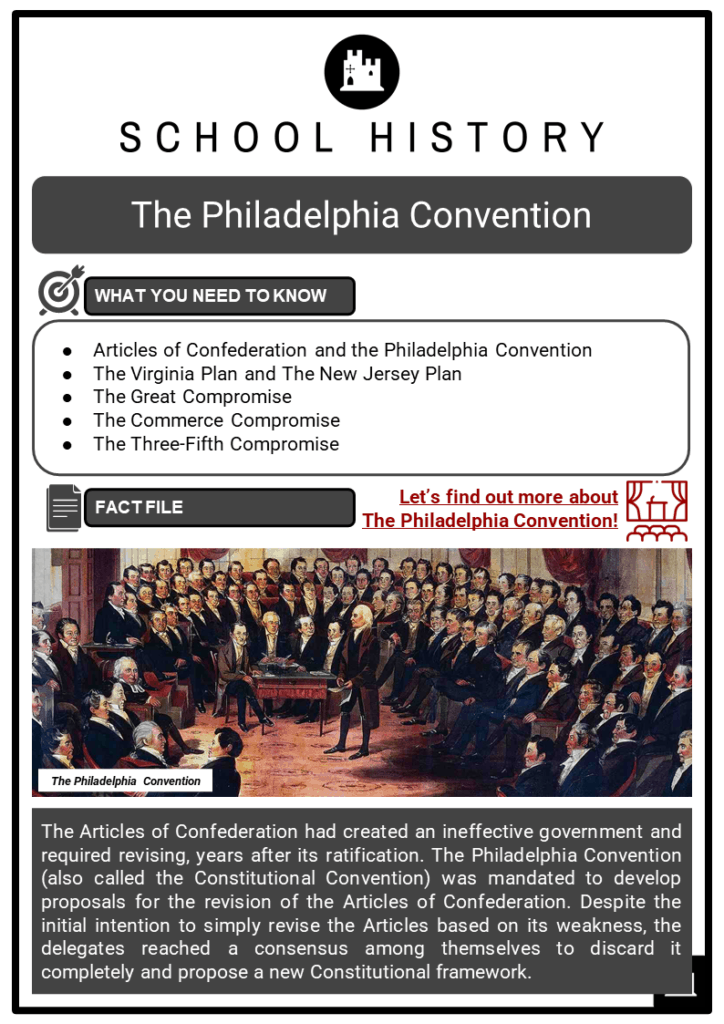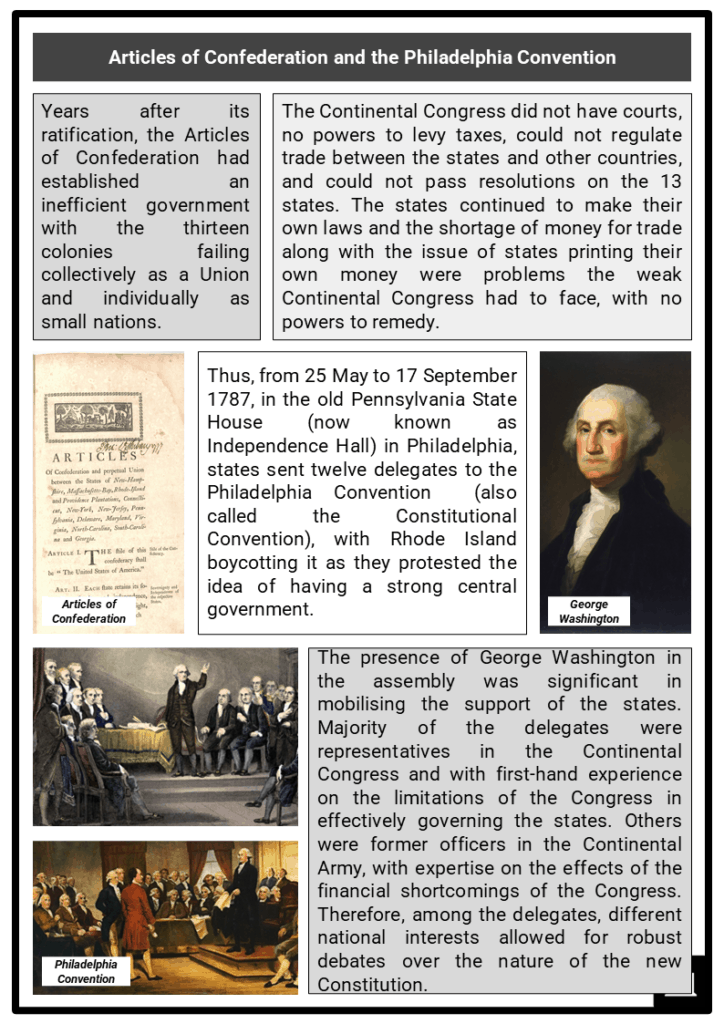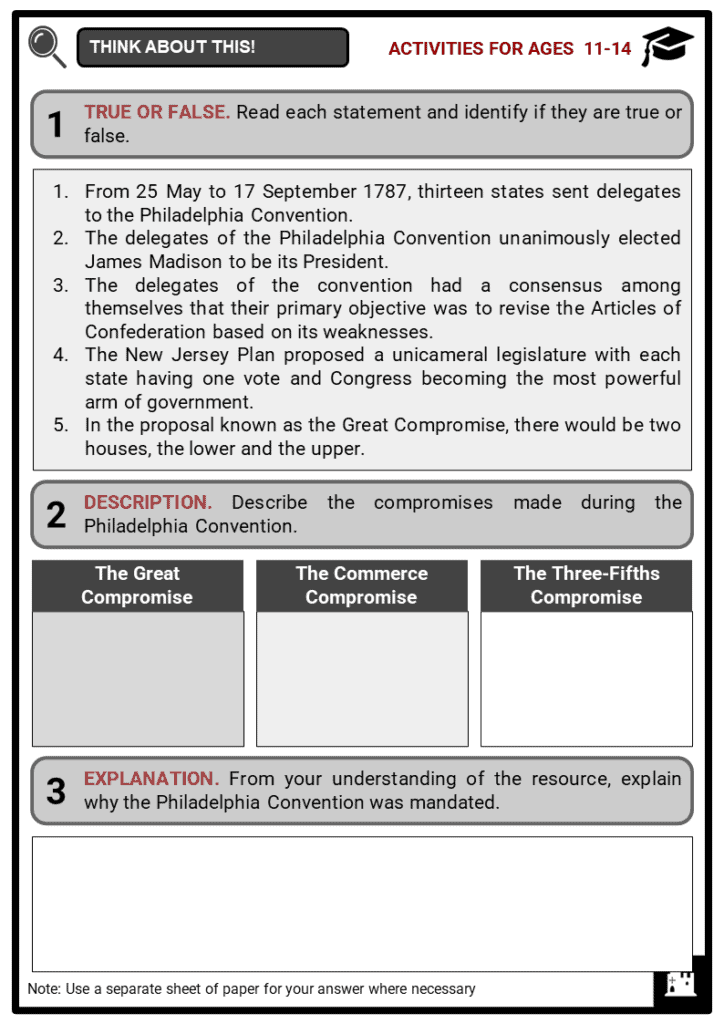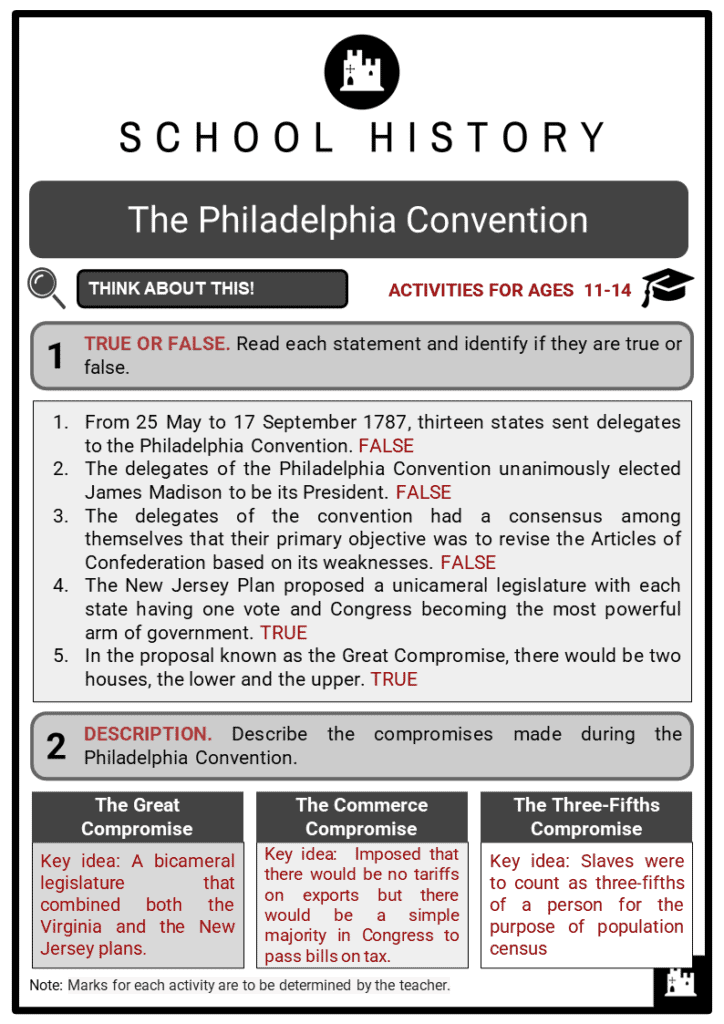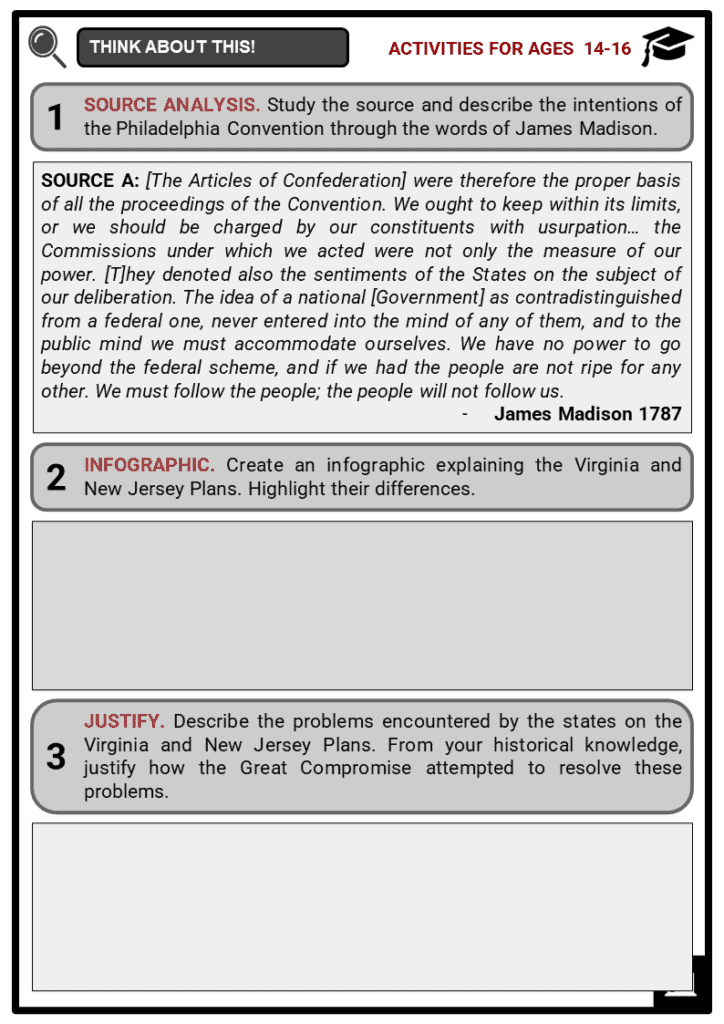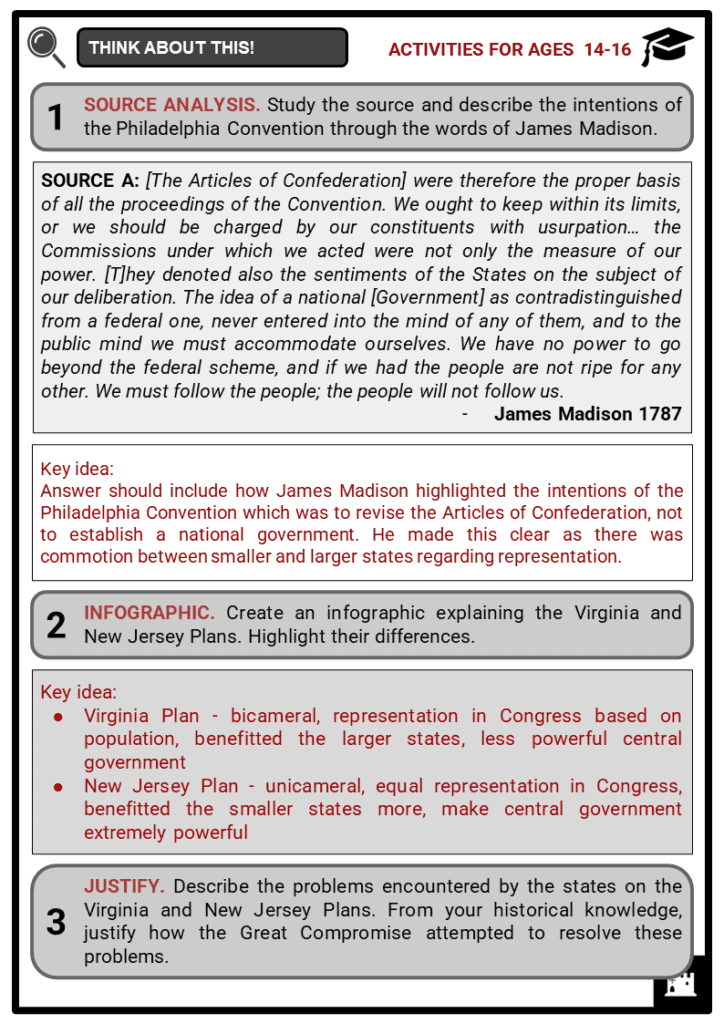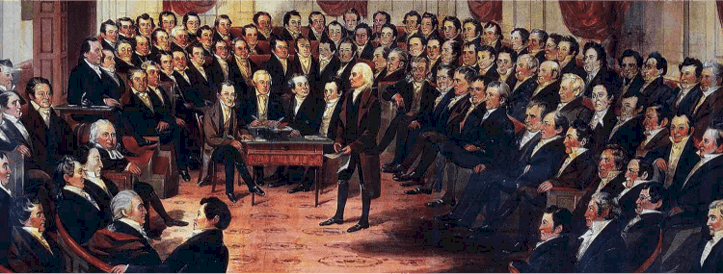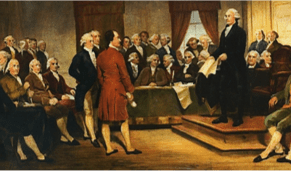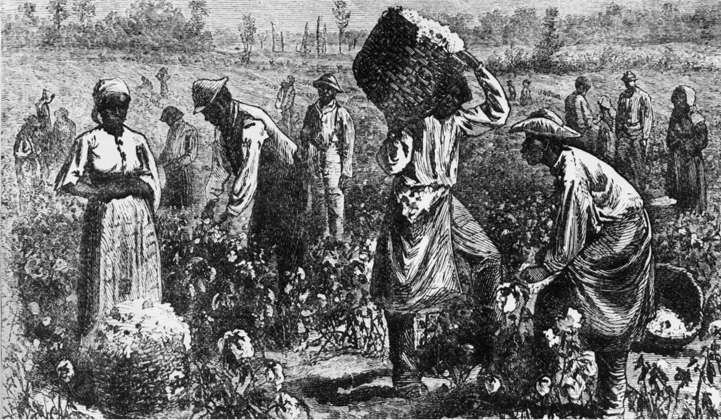Download The Philadelphia Convention Worksheets
Do you want to save dozens of hours in time? Get your evenings and weekends back? Be able to teach The Philadelphia Convention to your students?
Our worksheet bundle includes a fact file and printable worksheets and student activities. Perfect for both the classroom and homeschooling!
Table of Contents
Add a header to begin generating the table of contents
Summary
- Articles of Confederation and the Philadelphia Convention
- The Virginia Plan and The New Jersey Plan
- The Great Compromise
- The Commerce Compromise
- The Three-Fifth Compromise
Key Facts And Information
Let’s find out more about The Philadelphia Convention!
- The Articles of Confederation had created an ineffective government and required revising, years after its ratification. The Philadelphia Convention (also called the Constitutional Convention) was mandated to develop proposals for the revision of the Articles of Confederation. Despite the initial intention to simply revise the Articles based on its weakness, the delegates reached a consensus among themselves to discard it completely and propose a new Constitutional framework.
Articles of Confederation and the Philadelphia Convention
- Years after its ratification, the Articles of Confederation had established an inefficient government with the thirteen colonies failing collectively as a Union and individually as small nations.
- The Continental Congress did not have courts, no powers to levy taxes, could not regulate trade between the states and other countries, and could not pass resolutions on the 13 states. The states continued to make their own laws and the shortage of money for trade along with the issue of states printing their own money were problems the weak Continental Congress had to face, with no powers to remedy.
- Thus, from 25 May to 17 September 1787, in the old Pennsylvania State House (now known as Independence Hall) in Philadelphia, states sent twelve delegates to the Philadelphia Convention (also called the Constitutional Convention), with Rhode Island boycotting it as they protested the idea of having a strong central government.
- The presence of George Washington in the assembly was significant in mobilising the support of the states. Majority of the delegates were representatives in the Continental Congress and with first-hand experience on the limitations of the Congress in effectively governing the states. Others were former officers in the Continental Army, with expertise on the effects of the financial shortcomings of the Congress. Therefore, among the delegates, different national interests allowed for robust debates over the nature of the new Constitution.
- There were officers of the Continental Army who were left out from the convention. Among them were Thomas Jefferson and Patrick Henry, who were openly critical of the idea of a centralised government and the compatibility of republican principles such as popular elections in territories in the United States.
- The delegates of the convention unanimously elected George Washington to be the President of the Convention. James Madison, later acclaimed as the “Father of the Constitution”, had knowledge and ability to find unifying solutions to divisive aspects such as the bill of rights and the voting capacity of the states against the size of the population.
- The delegates’ consensus among themselves was that their primary objective was to discard the Articles of Confederation and propose a new Constitutional framework, contrary to the mandate given by the Continental Congress which was to simply revise the Articles based on its weakness.
The Virginia Plan and The New Jersey Plan
- James Madison developed a plan concerning the nature of the legislature and fronted it to Edmund Randolph, the delegate representing Virginia, who Madison thought was a better orator. Edmund proposed a legislature whose functions among others would be appointing the President and the Court officials. Edmund’s proposals were called the Virginia Plan. The other part of the plan provided for a bicameral legislature.
- Representation in both houses meant that states with more residents would have more representation than those of smaller states. This proposal was resisted by the smaller states because they feared that their voices would be drowned out by the larger states.
- William Paterson, a delegate from New Jersey, proposed an alternative plan addressing the concerns of the smaller states. The New Jersey Plan proposed a unicameral legislature with each state having one vote and the Congress as the most powerful arm of government, with the mandate to levy taxes and regulate trade.
- The executive and the judiciary would be separate arms and not as powerful as the Congress. Delegates from larger states were against the New Jersey Plan, stating that larger states deserved greater representation.
The Great Compromise
- There was a deadlock between the delegates of the smaller states and the bigger states, which required a compromise. Connecticut’s Roger Sherman proposed a bicameral legislature that combined both the Virginia and the New Jersey plans. In the proposal known as the Great Compromise (also called the Connecticut Compromise or the Sherman Compromise), there would be two houses, the lower and the upper.
- The Compromise proposed that the lower house be called the House of Representatives and its composition should reflect the population of the states, thus, larger states would have more members.
- The proposed name for the upper house was the Senate and its composition according to the Compromise would be a limit of two delegates from each state. The elections of Senators would be by the state legislatures, and the bills concerning taxes and revenue were to originate from the lower house and progress to the upper house once approved.
- The Compromise went on to propose functions of the President to include the power to elect key officials such as the Judiciary leaders, the ability to veto legislation, and also to function as Commander-in-Chief of the military.
The Commerce Compromise
- Trade regulation was another contentious issue. The Northern states wanted federal tariffs to keep out cheap European imports, thus widening the domestic tax base based on the volume of goods produced in the states. Cotton and tobacco-producing states, on the other hand, found a ready market in Europe and therefore did not want an export tariff introduced.
- The southern states asked for a two-thirds majority rule on bills concerning trade. Thus, a Commerce Compromise was reached mandating tariffs to only be allowed on imports from foreign countries and not exports from the U.S.
The Three-Fifths Compromise
- Slavery was the next issue up for discussion, and the question was whether slaves ought to be regarded as people or property. The consensus was that slaves were not entitled to the same rights as ‘whites’, but the Southern states, eager for more power, argued for slaves to be counted as people to increase the population size of the state and consequently the number of representatives in the House of Representatives.
- The Northern states, on the other hand, feared the idea of a powerful south and therefore argued that slaves be counted as property and subject to property tax to help raise revenue for the federal government. The Northern states also expected the African slave trade to progressively decline over time and argued for this to be reflected in the constitution. The southern states, however, resisted slave trade restrictions because the majority had slaves.
- A compromise was reached and slaves were to count as three-fifths of a person for the purpose of population census. The constitution saliently referred to slaves as “all other persons”. The Compromise also provided that Congress would not restrict overseas slave trade for the next twenty years. In 1808, Congress banned the foreign slave trade.
Image sources:
- https://www.thoughtco.com/thmb/6TjI6XTYYDVI8zUp6JfnUETBgtU=/1500x1000/filters:no_upscale():max_bytes(150000):strip_icc()/constitutional-convention-Virginia-58c81feb3df78c353c2cb11f.jpg
- https://www.washingtonpost.com/resizer/A0MHvy8cvnRQbbveriYPaqzeUrI=/1440x0/smart/arc-anglerfish-washpost-prod-washpost.s3.amazonaws.com/public/PBAMVWRAXUI6LLVZUQI2QTE5KU
- https://images.reference.com/amg-cms-reference-images/media/did-issue-slavery-differ-north-south_745df2204f5553e0.jpg

